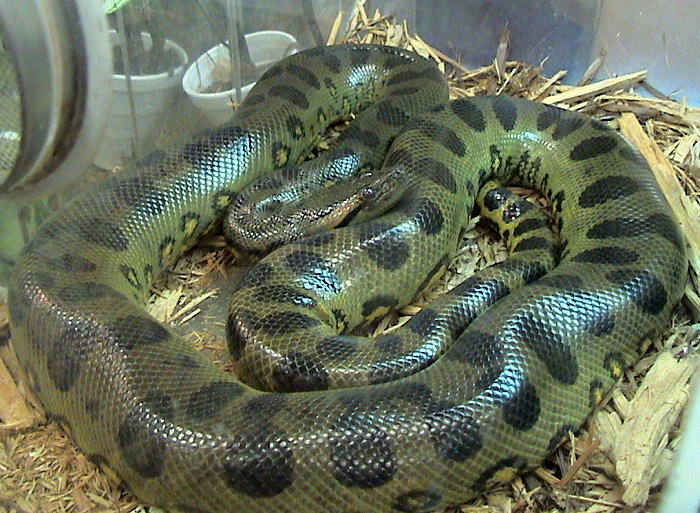The Green Snake Species Profile provides information on various green snake species, including the Rough Green Snake and the Smooth Green Snake. These snakes are nonvenomous and harmless to humans.
They are docile creatures that usually flee if threatened. Green snakes are known for their smooth, bright green dorsal scales and white or yellow ventral scales. They can be found in different regions of North America, including Texas, California, and North Carolina.
Green snakes are tree-dwelling and nocturnal, and they are also proficient swimmers. They have a common presence in their respective habitats and are not protected throughout most areas.
:strip_icc()/GettyImages-530917116-583b3f683df78c6f6ae77042.jpg)
Credit: www.thesprucepets.com
Overview Of Green Snake Species
Green snakes are a fascinating group of reptiles that are known for their vibrant coloration and unique characteristics. In this article, we will explore different types of green snakes, their conservation status, and some interesting facts about them.
Different Types Of Green Snakes
There are several species of green snakes found across the world. Here are a few notable examples:
- Rough Green Snake (Opheodrys aestivus)
- Smooth Green Snake (Opheodrys vernalis)
- Grass Snake (Natrix natrix)
- Green Whip Snake (Ahaetulla nasuta)
- Garden Snake (Opheodrys aestivus)
Each of these species has its own unique features and habitats, making them a diverse and fascinating group.
Conservation Status
The conservation status of green snakes varies depending on the species and their respective habitats. While some species may be more abundant and have stable populations, others might face threats and be considered endangered or critically endangered.
It is important to note that many green snakes play crucial roles in their ecosystems by controlling pest populations, pollinating plants, and serving as prey for other animals.
Interesting Facts About Green Snakes
Here are some intriguing facts about green snakes:
- Green snakes are nonvenomous and pose no threat to humans.
- They have excellent climbing and swimming abilities.
- Some species of green snakes are nocturnal, while others are active during the day.
- Green snakes are known for their vibrant, green coloration that provides effective camouflage in their natural habitats.
- These snakes are typically docile and would rather flee than engage in confrontation.
With their stunning appearances and interesting behaviors, green snakes are undoubtedly captivating creatures to study and appreciate. Their unique adaptations and ecological roles make them an essential part of our natural world.

Credit: srelherp.uga.edu
Characteristics And Behavior Of Green Snakes
Green snakes are a fascinating species known for their unique physical characteristics and interesting behaviors. In this section, we will explore the physical description, habitat and distribution, as well as the behavioral traits of these remarkable creatures.
Physical Description
Green snakes have a stunning appearance with their smooth, bright green dorsal scales and white or yellow ventral scales. These colors allow them to blend seamlessly into their surrounding vegetation, making them excellent at camouflage. They typically have slender bodies and can grow to lengths of about 2 to 4 feet. Their eyes are large and round, providing them with excellent vision.
Habitat And Distribution
Green snakes can be found in various habitats, including forests, grasslands, and even gardens. They are primarily tree-dwelling reptiles and are commonly found in North America. They have a wide distribution, ranging from states like Texas and California to areas as far as North Carolina. These versatile snakes have adapted well to different environments, allowing them to thrive in both rural and urban settings.
Behavioral Traits
Green snakes are known for their docile nature and non-aggressive behavior towards humans. They are nonvenomous and pose no threat to us. When threatened, these snakes are more likely to flee rather than confront their perceived adversaries. They are skilled climbers and can often be found resting on tree branches or among foliage.
In addition to their climbing abilities, green snakes are also exceptional swimmers. They can navigate through water bodies with ease, making them adaptable to various aquatic environments. This versatility in both arboreal and aquatic habitats has contributed to their wide-ranging distribution.
Green snakes are primarily nocturnal creatures, becoming more active during the night to hunt for prey. They have a varied diet, feeding on insects, spiders, small amphibians, and sometimes even small reptiles or birds. Their slender bodies and sharp teeth allow them to capture and consume their prey effectively.
Summary: Characteristics and Behavior of Green Snakes
Green snakes are striking reptiles with their vibrant green coloration and streamlined bodies. They thrive in different habitats and can be found in various parts of North America. Their peaceful nature, climbing and swimming abilities, and diverse diet make them fascinating creatures to observe in the wild.
Caring For Pet Green Snakes
Green snakes make fascinating and low-maintenance pets. Whether you own a rough green snake, smooth green snake, or another variety, it’s essential to provide them with proper care and an environment that mimics their natural habitat. In this article, we will explore important aspects of caring for pet green snakes, including housing and environment, diet and feeding, and health and care tips.
Housing And Environment
Creating an ideal housing and environment is crucial to ensure the well-being of your pet green snake. Here are some key considerations:
- Terrarium Size: Green snakes thrive in spacious enclosures. A terrarium measuring at least 30 inches long, 12 inches wide, and 18 inches tall is suitable for an adult green snake.
- Substrate: Choose a substrate that retains moisture, such as coconut husk or cypress mulch. This helps maintain humidity levels.
- Temperature and Humidity: Maintain a temperature gradient within the terrarium, with a warm side between 80-85°F and a cooler side between 75-80°F. Humidity levels should be around 50-60%. Use a combination of heat lamps, heating pads, and a hygrometer to monitor and regulate these conditions.
- Hiding Places: Provide multiple hiding spots using natural elements like rocks, branches, and foliage. This allows your snake to feel secure and reduces stress.
Diet And Feeding
Feeding your pet green snake a balanced and appropriate diet is essential for their health and growth. Here’s what you should know:
- Food Types: Green snakes are primarily insectivores, feeding on a variety of live prey such as crickets, mealworms, and small cockroaches.
- Feeding Frequency: Adult green snakes typically require feeding every 7-10 days, while younger snakes may need to eat more frequently.
- Prey Size: Choose prey items that are about the same width as the snake’s head to prevent choking.
- Supplements: Dusting prey with reptile-specific calcium and multivitamin supplements ensures your snake receives essential nutrients.
Health And Care Tips
To maintain the well-being of your pet green snake, follow these health and care tips:
- Veterinary Check-ups: Schedule regular check-ups with a reptile-savvy veterinarian to monitor your snake’s overall health and detect any potential issues.
- Handling: Handle your green snake gently and minimally to reduce stress. Avoid handling immediately after feeding.
- Cleaning: Clean the terrarium regularly, removing any waste or uneaten prey. It’s important to maintain a clean and hygienic environment.
- Observation: Observe your snake for any signs of illness or abnormal behavior. Loss of appetite, lethargy, or changes in skin condition could indicate an underlying health issue.
- Enrichment: Provide environmental enrichment by adding climbing branches, tunnels, and items for your snake to explore. This helps prevent boredom and stimulates natural behaviors.
By following these tips and providing the right care and environment, you can ensure your pet green snake leads a healthy and fulfilling life in your care.

Credit: nas.er.usgs.gov
Frequently Asked Questions On Green Snake Species Profile
How Rare Are Green Snakes?
Green snakes are generally common and not rare. They are nonvenomous, harmless, and docile. Rough green snakes usually live in trees but can also swim. Smooth green snakes have a uniformly light green back and a yellow or white belly.
What Are Some Interesting Facts About Green Snakes?
Smooth green snakes are nonvenomous, docile, and harmless to humans. They usually flee when threatened.
What Kind Of Green Snakes Are There?
There are several species of green snakes, including the rough green snake, smooth green snake, grass snake, and green whip snake. These snakes are nonvenomous and docile, posing no threat to humans. They are often found in trees and are good swimmers.
Are Rough Green Snakes Aggressive?
Rough green snakes are not aggressive and do not bite. They are docile creatures and are good swimmers.
Conclusion
Green snakes are fascinating creatures that offer both aesthetic beauty and ecological value. From the nonvenomous and harmless smooth greensnake to the docile rough green snake, these species provide a unique glimpse into the wonders of nature. Whether they inhabit trees, grass, or gardens, green snakes are a sight to behold.
With their vibrant colors and sleek appearance, they add a touch of elegance to any natural environment. Moreover, their presence helps maintain the balance of ecosystems by controlling pest populations. So, next time you encounter a green snake, remember to appreciate its beauty and significance in our world.


